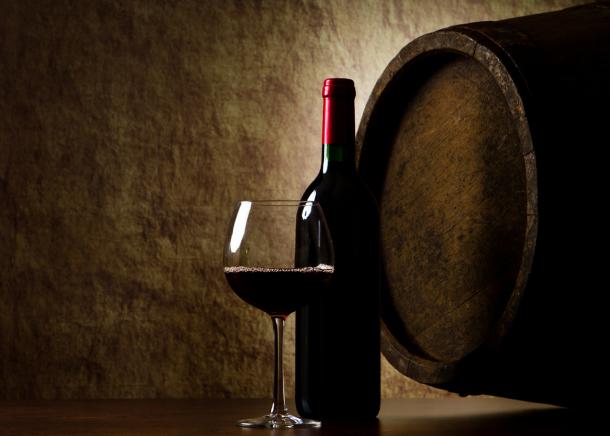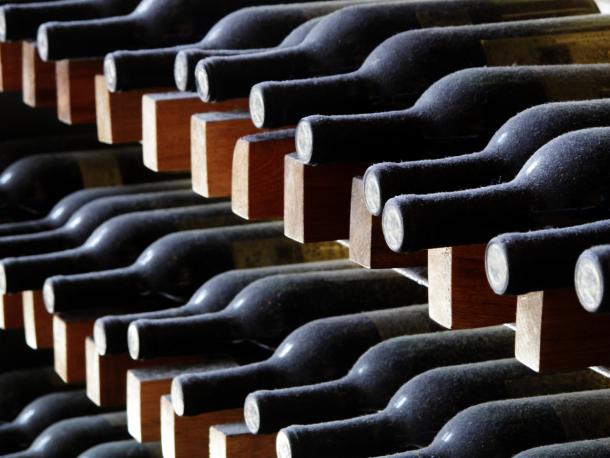Storing Italian Wines: How to Create a Wine Cellar
There are many advantages to creating your own personal wine cellar, as opposed to using a commercial storage facility. The most obvious advantage is that you can select and drink something from your collection anytime you want to, rather than having to plan ahead and make arrangements for your wine to be released from bond.

Another advantage for the serious wine collector is that a good deal of money can be saved on buying newly released vintages in bulk, or during sales. And of course, there is the sheer joy of having one’s collection at home and being able to peruse it at will and share it with others.
Choosing Italian wines
Any wine cellar can be greatly enhanced with a collection of fine Italian wines. Italy produces the greatest diversity of wines in the world, from sleek, modern reds and whites made from well-known grapes like Cabernet Sauvignon and Chardonnay, to rich, powerful and ageworthy wines from Italy’s own range of grapes, many of which are not found outside their native land. From bone-dry whites to sweet nectar-like dessert wines to full-bodied reds, Italy offers a kaleidoscope of flavours and aromas not available anywhere else on earth. The most serious wines are intense and complex, while others are delicate and intended for sheer indulgence and enjoyment.
Red wines
With their relatively high acidity, Italy’s wines are excellent companions for the country’s cuisine and also for modern and traditional dishes from other parts of the world. You do not need to spend a great deal in order to secure a wine that perfectly complements a dish, whether it is a crisp, well-structured white or a rich, ripe red. If you are thinking of laying down some Italian wines in your cellar, then there is a great selection of wines to choose from. Barolo, historically, has had the reputation of being capable of great age. The structure of wines made from the Nebbiolo grape (Barolo, Barbaresco, Ghemme, Gattinara) is such that while they may sometime taste closed or unapproachable in their youth, the finest examples can age for 50 years or more. The concentrated Amarone-like Sfursat from Valtellina, also made from Nebbiolo, has extraordinary potential to age.
Equally popular is the Sangiovese, the grape behind Brunello di Montalcino, Chianti Classico Riserva and Vino Nobile di Montepulciano. The finest examples of Sangiovese can age for decades, becoming highly complex and rich but well-balanced with acidity. This versatile grape is also used in everyday drinking wines that are light and quaffable, but it is in the intense Brunellos that the grape really demonstrates its complex character.
The passito method of drying grapes on straw mats is used to make powerful wines with high alcohol and great concentration like the mighty Amarone from Veneto. Gaining in popularity in recent years, this is a serious wine for the cellar to be enjoyed in the future. But it is not just these high profile wines that can benefit from cellaring – may of Italy’s lesser known red wines will also improve with age, such as Taurasi from Campania, and Umbria’s Sagrantino di Montefalco. Italy’s own noble grape varieties, together with modern vinification techniques, are turning out wines with an excellent structure that means they are capable of improving in bottle for many years, and many of them are not terribly expensive.
The Italians have also gained a reputation for excellent wines made from classic Bordeaux varietals like Cabernet Sauvignon and Merlot. These grapes are used in Italy to make not just single varietals and Bordeaux-style blends, but also in blends with native grapes to make some of the exceptional “Super Tuscan” wines that have emerged in recent years. Such wines are expensive and have begun to gain recognition on the secondary market, fetching high prices at auctions worldwide as buyers in the Far East and Russia have sought to extend their interest in wine beyond France. Nonetheless, you do not need to spend a great deal to find an Italian Cabernet that will improve in bottle. Good Pinot Noir from Italy – the grape is quite widely grown now – can improve for a decade or more.
White wines
Of course it is not just red wines that can benefit from age. Although they do not have the ageing potential of the reds, many of Italy’s dry whites will improve in bottle for a few years. Gavi from Piedmont and Vernaccia di San Gimignano from Tuscany from the best vintages can improve over time, displaying a complex bouquet and a rich, honeyed palate. Some of Italy’s fine Chardonnays are at their best a few years after their release, as well as the modern dry Rieslings from the mountainous North. Not all of Italy’s whites will improve over time and those that are intended for early drinking tend to have a nice floral, aromatic freshness that is best enjoyed in its youth. If you are not sure, check with your wine merchant.
Sparkling wines
Italy’s most famous sparkling wines, Asti Spumante and Prosecco, are intended to be enjoyed while young and fresh; they are not intended for ageing. Nonetheless, Italy produces many other sparkling wines using the “traditional” or “Champagne” method, from the same Pinot Noir and Chardonnay grapes that are used in Champagne, and these can age with grace for several years. Although they are harder to come by in other countries, they are worth searching for as they share Champagne’s elegant character and rich flavour but cost only a fraction of the price. The best examples are made in Piedmont, Lombardy and Trentino-Alto Adige.
Dessert wines
Although they do not receive as much recognition as sweet wines from other countries, the Italian range is extraordinary, encompassing sweet reds and whites, and even sparkling. Passito and Recioto wines are highly concentrated with a luscious honeyed character. Tuscany’s Vin Santo is one of the most popular exports – with its amber colour and nectar-like character it is a natural partner for rich desserts and cheeseboards. Most of Italy’s dessert wines are made with ageing in mind, so you can safely lay them down for a few years and they will undoubtedly improve. However it is the rich Marsala that will age for the longest – this fortified wine requires minimal attention and will continue to develop in bottle for decades.
Choosing a location for your cellar
Although it is preferable to store wines underground, underground cellars vary greatly in quality and there are many factors to consider. Any sign of mould on the walls might be a cause for concern, as excessive humidity can spoil the wines. If you intend to cellar a lot of wine for the long term, for either investment or drinking purposes, you must be very careful to ensure that the wine is kept at optimal levels of humidity and temperature, in the absence of harmful light and vibrations.
It is recommended that you consult a professional who will help you optimise the conditions in your cellar, although if your goal is simply to lay down a few selected cases for the future, it is then worth noting that most quality wines that are intended for ageing have a robust structure and are really quite resilient. A modern wine cabinet is a good alternative if you do not have a cellar – they are not suitable for extremely large collections but a variety of sizes and styles are available and they provide an ideal environment. Again, the cabinet will need to be kept well away from light and vibrations.

Wines must be stored on their sides, in order to prevent the corks from drying out, which is why wine racks or bins are used to house individual bottles. It is recommended that you do not keep different wines within one bin, because rummaging for a particular wine can jolt and disturb the bottles. You can order a custom-made wine rack from various merchants to fit your cellar space. They can be made from cement, ceramic, wood or metal, it does not matter. The most important criteria is that they must be extremely sturdy.
Organising your collection
Once you have the right cellar conditions in place, the key to good cellar maintenance is minimising the disturbance to your wines. Wines that are silently maturing do not like to be moved, and so pristine organisation will go a long way towards this. Categorise your wines so that you know where to find your reds, whites, sweet and sparkling. Gently remove the wines from their boxes, wipe then with a clean dry cloth and lay them with the labels facing upwards for easy identification. Remove any heavy foil capsules – these will become obsolete in the next few years in any case. Placing indentification tags on the bottle necks is a good way of identifying your wines without moving them. Keeping a notebook is useful too – you can diarise when you bought the wine, and some notes about its longevity. If you have tasted it before, you can also provide a tasting note and a score, so you can compare the next bottle that you open to see if the wine has improved.
Ongoing care and maintenance of your wine cellar
However diligently we consult authoritative tasting notes by experts on when each wine from each vintage should be drunk, every bottle is capable of throwing up a surprise and we never quite know when it will reach its peak. Buying a case of wine and tasting a bottle every few years is its own reward, and you can be the judge of when the wine truly reaches perfection. Some of the world’s most experienced tasters have identified that some top wines go through a “sleep” during their maturation, whereby the flavours that were emerging on the last time of tasting have closed, so for a period the wine is difficult to taste, yet it has not passed its peak and it’s flavours will eventually emerge when the wine is good and ready. Regular tasting experience will go a long way towards helping you to identify when a wine will be ready to drink.
Buying Italian Wines
If you are getting to grips with Italian wines for the first time, spend some time tasting wines before committing to a large purchase. There are so many different styles, it is really important to find one that suits you. Many people who do not like French wines will really enjoy traditional Italian wines made from indigenous grapes, as they are so different from the classic style. Similarly, many people who struggle to get to grips with Bordeaux and New World Cabernets will find that Italian modern reds are just what they have been looking for. Make sure to taste wines from different regions within Italy, and be sure to try as many diverse and unusual wines as you can.
In best practice, your cellar should be in constant motion – it will be well-stocked with a wide variety of wines, but bottles will enter and leave all the time in order to maintain a dynamic and interesting collection. Many collectors like to have a range of wines from each price point – cheaper wines for “everyday” drinking, slightly more expensive wines for special occasions, and extra special wines for longer term cellaring, perhaps with a particular occasion in mind. There is a wide variety of Italian wines, red, white, sweet or sparkling, at every level, and so the choice is yours. Even without spending a great deal per bottle, your Italian wine cellar can still be filled with a rich, exciting selection of bottles that you simply cannot wait to start tasting.
Creating your own Wine Cellar

